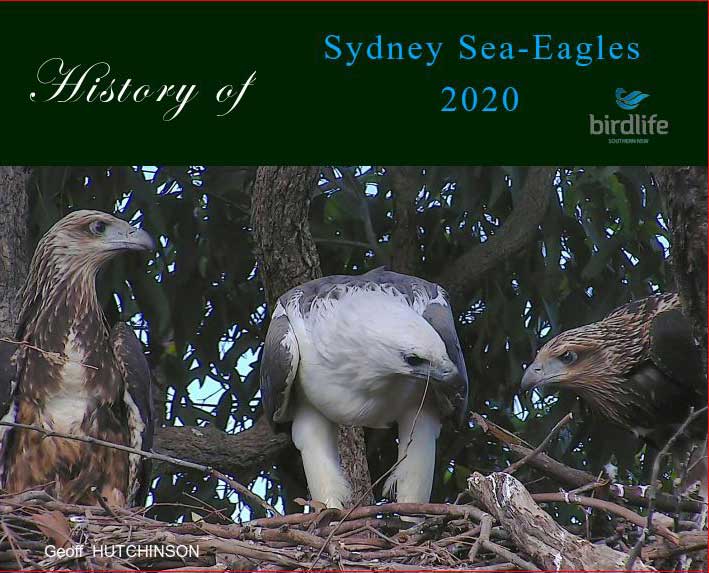Judy Harrington, Geoff Hutchinson, Jon Irvine, BirdLife Southern NSW.
Report on the 2015 nesting of the White-bellied Sea-Eagles
in the Newington Nature Reserve Forest
at Sydney Olympic Park
in the Newington Nature Reserve Forest
at Sydney Olympic Park
There has been a Sea-Eagle nest in the Newington Nature Reserve at Sydney Olympic Park by the Parramatta River for many years, with a succession of eagle pairs renovating the nest in the breeding season. There are few early records of successful breeding however and several eagles have been found dead. Following the death of a pair of breeding eagles in 2004, necropsy and chemical analysis of tissues was undertaken in order to determine the cause of death. Further study was recommended. Their success or failure appears to be closely linked with environmental conditions, particularly the accumulated persistent organic pesticides in Homebush Bay and the Parramatta River.
As in previous years since 2009, the breeding relationships, behaviour and diet of the White- bellied Sea-Eagles were studied using video CCTV cameras and by limited physical observation during daylight hours, from the time of nest renovation to fledging. In early 2015 a new Research Proposal was submitted and all approvals gained.
In 2014, a new nest (Nest 3) was built in an Ironbark tree some 100 metres from the nest used in 2013 (Nest 2). However, after some apparent disturbance the eagles returned to Nest 2. In 2015, they began renovations on Nest 3 in May, bringing sticks to build up the rails, or edges, of the nest and fresh leaves to line it. As previously observed, both eagles assisted in the construction stage.
Over all these years of observations, though initially there was no night time footage, there seems to be a definite trend for delayed incubation between the first egg laid and the second. The time between laying of the two eggs varied from three to five days when we were able to observe the lay. Eagles may exhibit "obligate siblicide", in which the larger chick invariably kills its smaller sibling; we have not observed this in our study.
The first egg SE-15 was laid - 26 June 2015, 11:55pm.
The second egg SE-16 was laid - 30 June 2015, 05:43am.
Our study raises some interesting observations. Though the eggs were laid about 78 hours apart, the second eaglet hatched very close to the first, suggesting a tactic of delayed incubation, rather than just asynchronous hatching, which would normally give the first chick hatched an advantage.
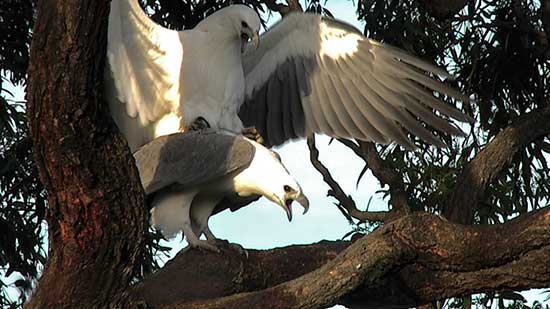
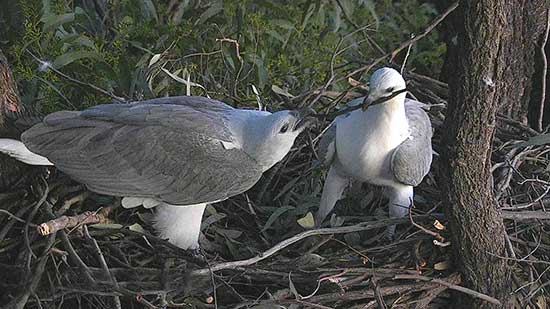
Both parents share incubation, though only the female incubates at night. Between around midnight, when she laid the first egg, and early morning when she left, the egg was uncovered seven times, for just over an hour in total, the longest period being for 20 minutes. When incubating, the female usually slept, with eyes closed or head tucked under her wing. When the eggs were uncovered, at times she stood sleeping on the edge of the nest. On the second night, not only were the eggs uncovered, but she was away from the nest completely twice, for a total of 4.5 hours – noting it was Winter and cold. Both eagles shared incubation during the day, though again in the early stages after the first egg was laid, nest posture probably indicated guarding rather than full incubation. The egg was again unattended for periods.
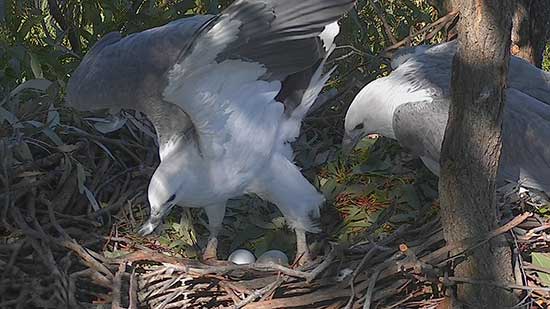
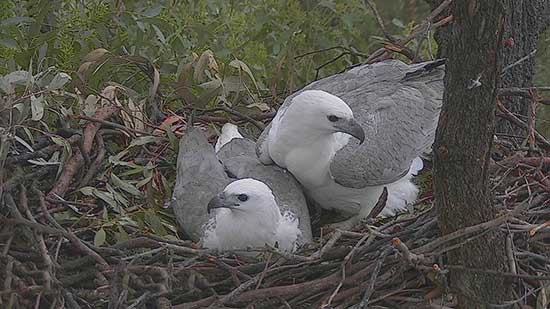
First egg (SE-15) hatched 7 August 2015, 01:00
Second egg (SE-16) hatched 7 August 2015, 16:00
The second chick, SE-16, hatched only 14.5 hours later than the first (SE-15), after being laid 78 hours apart. From the beginning, the second chick was stronger and bigger than the first, although they did catch up somewhat in size and strength. It was presumed that SE-16 was a female and confirmed that SE-15 was a male.
Both parents brooded the young, brought food and cared for the young, as in past years. Food brought included several species of fish, eels, turtles, blue-tongued lizards and a few birds.
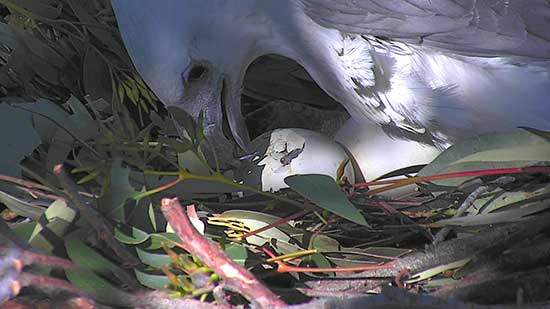
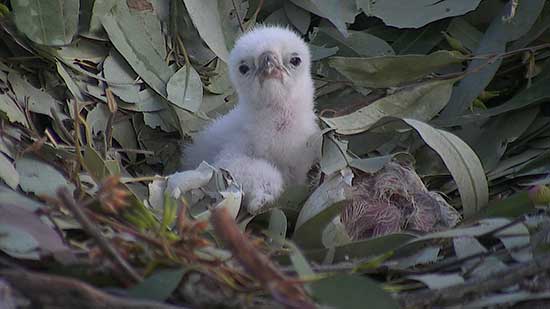
SE-15 branched at around 80 days, but never fledged.
On 1 November, this older eaglet SE-15, after some attempts at branching, missed the nest and landed on a lower branch, fell to the ground and was unable to get back to the nest. As he was at risk on the ground and at risk, approval was obtained for rescue and transfer to the Animal Referral Hospital for assessment and treatment. After discussion with SOPA and OEH, he was transferred to the Taronga Wildlife Hospital for treatment. After some time, new feather growth was showing malformation and his beak was showing deformity. Finally the eaglet was diagnosed with beak and feather disease. This condition is also referred to as: Non-Psittacine (meaning: not a parrot) beak and feather disease (PBFD); Non-Psittacine Circoviral Disease (PCD); or Circovirus.
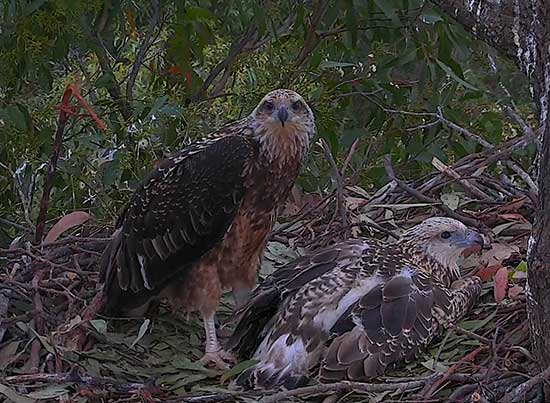
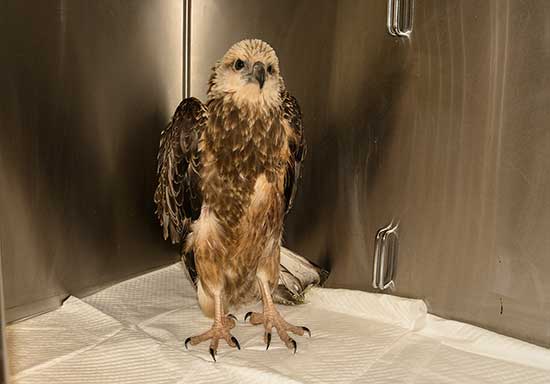
His condition worsened and euthanasia was deemed necessary. Larry Vogelnest, the senior vet at Taronga Wildlife Hospital stated: “He has deteriorated recently, appetite reduced, demeanour changed and his beak had to be trimmed so he could eat. I also feel now that it is unlikely he will ever have normal feathers. All new feathers coming through are abnormal and often break easily resulting in haemorrhage. It was no longer in the bird’s best interests to keep him alive in the faint hope he may recover.” A necropsy has been performed and extensive testing will be undertaken to learn more about beak and feather and its associated pathology. SE-15’s legacy will be that this information may contribute towards the understanding of how this virus affects raptors. We have also received a pathology sample for POP (Persistent organic pollutants) testing. This sample, when analysed will be compared to the other data gathered over the duration of this research project.
The younger fledgling, SE-16, was last seen at the beginning of December and is presumed to have moved out of the nesting territory.
The female was last seen on 21st February, when the pair were seen on their mangrove river roost on the Parramatta River. Before that date, both had been seen in Burns Bay, along the river and in the nest area. The female had been showing signs of distress for some time and her return is unlikely. From observations in the past, there are lone adults or juveniles, searching for a mate or territory and hopefully the current male may find a new mate.
This pair has nested every year since 2009 with an average of 1 young fledged per breeding attempt. They laid 2 eggs in each year, giving a mortality rate of 50 percent, “mortality” meaning eggs that failed to hatch or young that died in the nest. Compared to other studies conducted over several years they still maintain a normal “success” rate after many years of failed breeding.
www.environment.nsw.gov.au/threatenedspeciesapp/profile.aspx?id=20322

